
Speak with Confidence: A Comprehensive Handbook of Techniques and Strategies to Tackle Public Speaking Anxiety
Have a speaking event coming up AND have speaking anxiety?
Here’s the only guide you’ll ever need to help you manage your speaking anxiety in your next meeting or presentation.
No fluff.
Go dig in!
Your Speaking Coaches
- Kit Pang
Founder, BostonSpeaks
p.s. Two quick notes:
- Amount of info - Don't get caught up in technique overload! We've got a whole bunch of strategies to tackle public speaking anxiety. Pick your top 1 to 3 techniques, the ones that catch your eye or speak to you. Then take action.
- Why are there so many different ways? You can say the same for modes of transportation. You can go from your house to downtown by taking a bus, walking, driving, scooter, etc. That’s because people have different preferences. We are offering you different methods of going from Point A (Speaking Anxiety) to Point B (Free from Speaking Anxiety). Choose the ones that best fit you.
Looking for further speaking anxiety help?
- Register for the public speaking anxiety training: https://www.bostonspeaks.com/nofearspeaking
- Schedule a call to see how we can help you break free from public speaking anxiety: Book a call here.
Table of contents:
- Cognitive Techniques
- Somatic Techniques
- Behavioral Techniques
- Street Smart Techniques
- Unconventional Techniques
- Influencer Techniques
- BostonSpeaks Top Picks
- Gina’s Techniques
- Kit’s Techniques
Cognitive Techniques
What are Cognitive Techniques?
It's all about your mindset.
These are the strategies that focus on addressing and modifying the thoughts, beliefs, and interpretations that contribute to your speaking anxiety. These techniques aim to identify and challenge negative or unhelpful thinking patterns and reframe them so you’ll be able to see your speaking situation in a whole new way.
Why are Cognitive Techniques important?
They directly address the thoughts and beliefs that contribute to your speaking anxiety and shape your emotional and behavioral responses. The way in is the way out.

The Cognitive Techniques:
#1 Cognitive Restructuring: This technique involves identifying and challenging negative thoughts related to public speaking and replacing them with more balanced and realistic thoughts.
Do This: Identify an automatic negative thought related to public speaking. Challenge the thought by asking yourself, "What evidence do I have that supports this thought? What evidence contradicts it?" Identify 3-5 thoughts.
Example: "I'll embarrass myself." TO "I have prepared well, and even if I make a mistake, it won't define my entire presentation."
#2 Thought Records: Thought records help analyze and challenge anxious thoughts by recording the triggering event, automatic thoughts, associated emotions, and physical sensations. They facilitate the process of replacing negative thoughts with more helpful alternatives.
Do This: Use a thought record to examine a specific anxious thought about public speaking. Write down the triggering event, the automatic thought, associated emotions, and physical sensations. Then, challenge the thought and replace it with a more helpful alternative. Do 1-3 thought records.
Example:
- Trigger Event: Meeting with higher-ups
- Automatic Thoughts: Everyone will notice if I stumble over my words
- Emotion: Anxiety, Doubt
- Physical Sensation: Stomach acting weird
- Helpful Alternative Thought: It's common to stumble occasionally while speaking, and it won't have a significant impact on the overall message.
#3 Event Reframing: Event reframing involves changing the way you interpret and perceive public speaking situations by finding alternative explanations, positive aspects, or more adaptive perspectives to the event.
Do This: Choose a speaking moment that you’ve experienced in the past and note the meaning you’ve given to the event. Reframe this meaning by identifying alternative interpretations and explanations of the event. Choose 1-3 speaking events/situations/moments in the past that caused speaking anxiety for you.
Example:
Speaking Event/Moment: Someone in the audience looked at their phone the entire time.
Meaning I Gave To Event: I’m losing their attention. I’m so boring
Alternative Interpretation To Event: That audience member had an important meeting later on and was glued to her emails looking for updates, it had nothing to do with my content or me at all.
#4 Decatastrophizing: Decatastrophizing helps reduce catastrophic thinking by challenging exaggerated beliefs about negative outcomes in public speaking. It involves examining the likelihood and consequences of potential mishaps realistically.
Do This: Imagine a worst-case scenario related to public speaking, such as forgetting your lines. Challenge the catastrophic thoughts by considering more realistic outcomes and their likelihood. Focus on coping strategies you could employ in such situations.
Example:
The Catastrophic Thought - "If I forget my lines, the whole presentation will be a disaster.":
The Challenge - "What's the likelihood of forgetting my lines? Even if it happens, can I recover and continue? Have I handled similar situations in the past? Yes, I have forgotten my lines in the past. When I asked people if they noticed, no one had a clue about what I was talking about. Even if I forgot my lines, the damage it will do to my presentation is probably 0.00000000000001%.”
#5 Socratic Questioning: This technique involves asking probing questions to examine the evidence and validity of anxious thoughts, challenging assumptions, and exploring alternative perspectives.
Do This: When you experience anxiety about public speaking, ask yourself probing questions, answer them, then question them again. Give yourself two characters for this exercise. Aim for 3-8 questions.
Example: Anxious Thought - "Everyone will judge my performance negatively."
Person A: "I feel like everyone will judge my performance negatively."
Person B: "Why do you think everyone will judge your performance negatively?"
Person A: "Well, I'm not very confident in my abilities, and I've made mistakes in the past. I'm worried that people will focus on those mistakes and have a negative opinion of my performance."
Person B: "Is it fair to assume that everyone will judge your performance negatively based on your past mistakes?"
Person A: "I guess not everyone, but maybe most people."
Person B: "How can you be certain that most people will judge your performance negatively? Have you received feedback from most people about your past mistakes?"
Person A: "No, I haven't received feedback from most people. It's just my assumption based on my doubts and insecurities."
Person B: "So, could it be possible that your assumption about everyone judging your performance negatively is influenced more by your fears and self-doubt rather than actual evidence?"
Person A: "Yes, I suppose so. I may be projecting my negative thoughts onto others."
Person B: "Considering that you haven't received feedback from most people and that your assumption is influenced by your doubts, is it fair to conclude that everyone will judge your performance negatively?"
Person A: "No, it wouldn't be fair to make such a broad generalization based on limited evidence and my fears."
Person B: "What alternative perspectives could you consider when it comes to how people might judge your performance?"
Person A: "I could consider the possibility that some people may appreciate my efforts and focus on the progress I've made rather than dwelling on past mistakes."
Person B: "Exactly! By considering alternative perspectives, you open yourself up to the possibility that not everyone will judge your performance negatively. It's important to challenge negative assumptions and give yourself a fair chance."
#6 Self-Compassion: Self-compassion involves treating yourself with kindness and understanding. It helps counter self-criticism and fosters a nurturing and supportive inner dialogue.
Exercise: Write a self-compassionate letter to yourself, acknowledging your fears and offering understanding and support. Remind yourself that it's normal to feel anxious and reassure yourself with kind and compassionate words.
Example: Self-Critical Thought(s) - "I always mess up and never do well."
Dear Self,
I want to take a moment to acknowledge the fears and self-critical thoughts that have been weighing on you, especially the belief that you always mess up and never do well. I understand how these thoughts can be overwhelming and discouraging, but I want you to know that they do not define you or your abilities.
First and foremost, it's essential to remind yourself that making mistakes is a natural and necessary part of the learning process. Every successful person you admire has encountered setbacks and made errors along the way. Mistakes are not a reflection of your worth or potential. Instead, they provide valuable opportunities for growth and improvement.
It's important to challenge the notion of always messing up and never doing well. Remember that this belief is an exaggeration and a distortion of reality. Take a moment to reflect on your achievements and successes in public speaking. Recall the times when you delivered impactful presentations, received compliments, or positively impacted others through your words. These instances serve as powerful evidence that contradicts the belief that you never do well.
You are capable, resilient, and deserving of self-compassion. Believe in yourself and your potential. Embrace the journey, knowing that each step forward is a step closer to realizing your goals and making a meaningful impact.
With unwavering support and belief in you,
[Your name]
#7 Positive Affirmations: Positive affirmations are empowering statements that counter negative self-talk and reinforce positive beliefs about yourself and your public speaking abilities.
Do This: Take a moment to create a personalized list of positive affirmations that are specifically tailored to your public speaking journey, speaking situations, and self-esteem. These affirmations will serve as powerful reminders of your strengths, abilities, and worth as a speaker. Embrace this opportunity to uplift and empower yourself through positive self-talk. Write down affirmations that resonate with you and align with your goals, and use them as daily reminders of your potential and the positive impact you can make through your speeches.
Examples:
- I am confident and capable of delivering powerful speeches.
- I embrace the opportunity to share my ideas and inspire others through public speaking.
- My voice is unique, and it deserves to be heard.
- I am well-prepared and knowledgeable about my topic.
- I radiate confidence and charisma when I speak in front of an audience.
- Every presentation I give is an opportunity for personal and professional growth.
- I am a captivating speaker who engages and connects with my audience.
- I trust in my ability to handle any unexpected challenges that may arise during my speech.
- I am grateful for the opportunity to contribute and make a positive impact through my words.
- I am calm, centered, and in control of my nerves during public speaking engagements.
- My passion and enthusiasm shine through when I speak, captivating and inspiring those who listen.
- I embrace constructive feedback as a means to improve and refine my public speaking skills.
#8 Mindfulness: Mindfulness techniques involve cultivating non-judgmental awareness of the present moment, including thoughts, emotions, and bodily sensations. Mindfulness helps reduce distraction, enhance focus, and manage anxiety effectively.
Exercise: Practice a short mindfulness meditation before a speaking engagement. Focus on your breath, observe your thoughts and emotions without judgment, and bring your attention back to the present moment whenever it wanders.
Meditation App: Medito - https://meditofoundation.org/medito-app
This is my favorite meditation app and it’s free! I have tried Calm, Headspace, Insight Timer, and some others.
#9 Evidential Reasoning: You might have been focusing on all the negative speaking events that you’ve had. It’s time to step outside that view. Evidential reasoning focuses on gathering evidence that supports your public speaking abilities, such as positive feedback or successful experiences, to counterbalance self-doubt. Even if you don’t think you have any, look for it!
Do This: Make a list of evidence that supports your public speaking abilities, such as positive feedback from previous presentations or compliments you've received. Refer to this list whenever self-doubt arises.
#10 - Probability Analysis: Probability analysis involves realistically assessing the likelihood of negative outcomes in public speaking situations, challenging irrational fears, and considering more balanced possibilities.
Exercise: Evaluate the probability of negative outcomes in public speaking realistically. Write down the likelihood of those outcomes occurring and counterbalance them with positive or neutral possibilities. Use a scale from 1 to 10, with 1 being highly unlikely and 10 being highly probable.
Example:
Likelihood of events happening:
Forgetting lines: 4
Looking so nervous, I’ll get fired: 1
Positive or neutral possibilities
Forgetting lines: Everyone forgets things. I’m not a robot and I’m human at the end of the day. When people forget their lines, I don’t give it a second thought
Looking so nervous, I’ll get fired: If I did look nervous, people will want to help me, not fire me.
#11 - Visualization: Visualization entails creating vivid mental images of successfully delivering a confident and engaging speech, helping build confidence and familiarity with positive outcomes.
Exercise: Close your eyes and visualize yourself delivering a successful and confident speech. Imagine the audience's positive response, engaging delivery, and feelings of accomplishment. Engage all your senses to make the visualization vivid and powerful.
Using cognitive techniques is powerful for managing public speaking anxiety because they directly address the negative thought patterns, beliefs, and perceptions that contribute to anxiety. By identifying and challenging irrational thoughts, you can reframe your thinking and develop a more balanced and realistic perspective on your speaking situations.
What are Somatic Techniques?
Somatic techniques for public speaking anxiety involve using the body and its physical sensations to manage and reduce anxiety symptoms. These techniques focus on regulating your body's response to stress to help you feel more calm and confident during public speaking engagements.
Why are Somatic Techniques important?
Here’s why:
- Regulation of the Nervous System: Somatic techniques help regulate your body's physiological response to stress. When faced with anxiety-inducing situations like public speaking, your body's sympathetic nervous system can become activated, leading to increased heart rate, shallow breathing, muscle tension, and other physical symptoms of anxiety. Somatic techniques, such as deep breathing and progressive muscle relaxation, activate the parasympathetic nervous system, which counteracts the stress response and promotes relaxation.
- Mind-Body Connection: Somatic techniques foster a stronger mind-body connection. Public speaking anxiety often manifests as physical sensations, such as tightness in the chest, butterflies in the stomach, or trembling hands. By focusing on these bodily sensations and learning to manage them, you can gain a greater sense of control over your anxiety. Developing a heightened awareness of your body allows you to recognize and address anxiety symptoms as they arise, reducing their impact on your overall well-being.
- Long-term Anxiety Management: Regular practice of somatic techniques can have long-term benefits for anxiety management, not just in public speaking but in various areas of life. By learning to regulate your body's stress response, you develop skills that can be applied in other stressful situations. Somatic techniques empower you to manage anxiety symptoms, promote relaxation, and improve overall well-being, providing you with a valuable toolset for navigating anxiety in different aspects of your life.
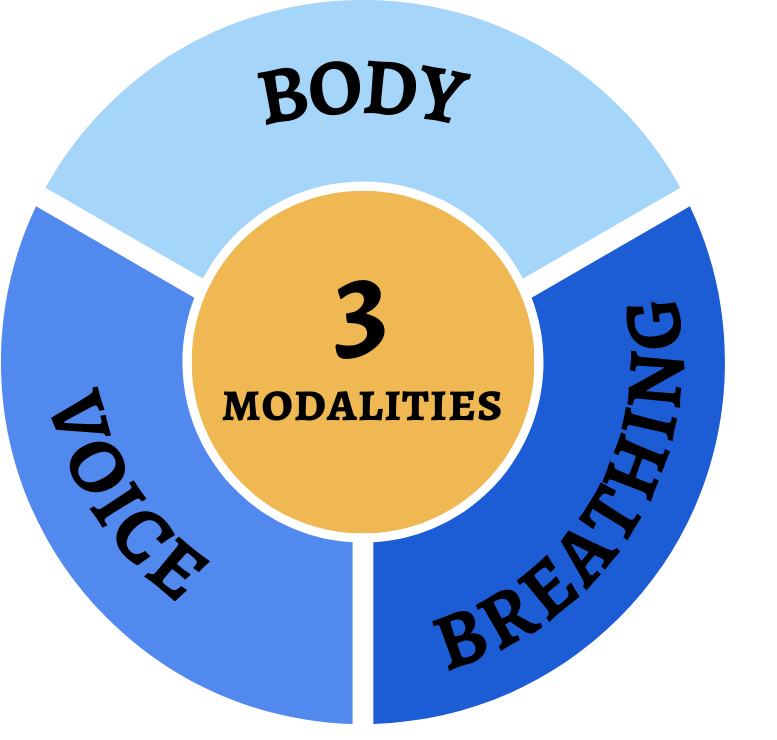
The Somatic Techniques:
Think of these 3 different modalities when considering somatic techniques: body, breath, voice
Body

1) Progressive Muscle Relaxation: Progressive Muscle Relaxation (PMR) is a technique where you systematically tense and then release different muscle groups in your body. Starting from your toes and working your way up to your head, you consciously tense each muscle group for a few seconds before releasing the tension. This exercise helps promote deep relaxation, releases physical tension, and enhances body awareness.
Here are the steps for practicing Progressive Muscle Relaxation:
- 1) Find a quiet and comfortable space: Choose a quiet environment where you can relax without distractions. Find a comfortable position, either sitting or lying down, whichever is most comfortable for you.
- 2) Take a few deep breaths: Begin by taking a few slow and deep breaths to help relax your body and focus your mind. Inhale deeply through your nose, and exhale slowly through your mouth.
- 3) Start with your toes: Begin the progressive muscle relaxation exercise by focusing on your toes. Curl your toes tightly, hold the tension for a few seconds (about 5-10 seconds), and then release the tension. Notice the difference between the feeling of tension and relaxation in your toes.
- 4) Move up to your feet and legs: Gradually work your way up your body, tensing and releasing each muscle group. Progressively tense and relax your feet, calf muscles, thighs, and so on. Tense each muscle group for a few seconds before releasing the tension. Pay attention to the sensations of tension and relaxation in each muscle group.
- 5) Continue up your body: Move from your legs to your abdomen, back, chest, shoulders, arms, hands, neck, and finally to your face and scalp. Tense each muscle group for a few seconds, and then release the tension, allowing your muscles to relax completely.
- 6) Focus on the contrast: As you go through each muscle group, focus on the contrast between the feeling of tension and the feeling of relaxation. Notice how the release of tension feels and how it differs from the initial tension in each muscle group.
- 7) Maintain deep breathing: Throughout the exercise, remember to maintain slow, deep breathing. Inhale deeply through your nose during the muscle tension phase, and exhale slowly through your mouth when releasing the tension.
- 8) Repeat if desired: You can repeat the progressive muscle relaxation exercise two or three times if you find it helpful. Each repetition can deepen your relaxation response and help release any remaining tension.
2) EFT Tapping: EFT (Emotional Freedom Techniques) involves tapping on specific acupressure points on the body while focusing on specific thoughts or emotions. It is believed to help release energy blockages and reduce anxiety. Yes, there is an APP for this. Click here to learn more.
3) Power Poses: Strike a confident and expansive posture before your presentation. Research suggests that adopting open and expansive postures, such as standing tall with your arms raised in a V-shape or placing your hands on your hips, can increase feelings of power and reduce stress levels.
Here are some ideas for power poses that you can try before your presentation:
- The Superman/Wonder Woman Pose: Stand with your feet shoulder-width apart, place your hands on your hips, and lift your chest with your chin slightly raised. Imagine yourself as a superhero, strong and confident.
- The Victory Pose: Stand tall with your feet hip-width apart and raise both arms in a V-shape above your head, forming a "V for victory" gesture. Hold this pose for a moment, feeling a sense of triumph and empowerment.
- The Star Pose: Stand with your feet wide apart and stretch your arms and legs out to form a star shape. Expand your body as much as possible, taking up space and radiating confidence.
- The CEO Pose: Sit in a chair with your back straight and your hands placed firmly on the armrests. Lean back slightly, and lift your chin to convey a sense of authority and control.
- The Warrior Pose: Stand with your feet wider than shoulder-width apart, bend your knees slightly, and place your hands on your hips. This pose conveys strength, readiness, and determination.
- The Raised Fist Pose: Stand with your feet shoulder-width apart and raise one fist in the air. Hold the pose for a few seconds, feeling a sense of empowerment and determination.
- The Tree Pose: Stand tall and shift your weight onto one leg. Place the sole of your other foot on your inner thigh or calf. Extend your arms overhead and balance. This pose promotes a sense of stability, strength, and poise.
4) Polyvagal Theory Exercises: techniques and practices based on the principles of Polyvagal Theory, a theory developed by Dr. Stephen Porges. Polyvagal Theory explores the connection between the autonomic nervous system, social engagement, and emotional well-being. These exercises aim to regulate the autonomic nervous system and promote feelings of safety, connection, and relaxation.
Here are some body-based exercises based on Polyvagal Theory that can help regulate your nervous system, increase feelings of safety and relaxation, and reduce anxiety associated with public speaking. Experiment with these exercises and choose the ones that resonate with you the most.
- Grounding through the senses:
- Find a quiet and comfortable space where you can sit or stand.
- Begin by focusing on your breath, taking slow and deep breaths to calm your nervous system.
- Then, shift your attention to your senses.
- Notice five things you can see, four things you can touch, three things you can hear, two things you can smell, and one thing you can taste.
- By engaging your senses, you redirect your attention to the present moment, promoting a sense of grounding and safety.
- Hand on Heart:
- Find a comfortable position and place one hand on your heart and the other on your abdomen.
- Take a few deep breaths, feeling the gentle rise and fall of your chest and belly.
- As you breathe, imagine sending warmth and compassion to your heart.
- This simple gesture activates the soothing aspect of your nervous system, promoting a sense of calm and self-soothing.
- Body Scan:
- Close your eyes and bring your attention to your body.
- Start at the top of your head and slowly move down, scanning each part of your body.
- Notice any areas of tension or discomfort without judgment.
- As you become aware of the tension, consciously release it and allow the muscles to relax.
- This exercise helps increase body awareness, release physical tension, and promote a sense of relaxation.
- Grounding with Weighted Objects:
- Find a weighted object like a weighted blanket, a heavy pillow, or a lap pad.
- Sit or lie down comfortably and place the weighted object on your lap or chest.
- Notice the pressure and sensation of the weighted object on your body.
- Allow yourself to sink into the support and grounding sensation it provides.
- This exercise helps activate the parasympathetic nervous system, promoting a sense of safety and relaxation.
- Gentle Movement and Stretching:
- Engage in gentle movements and stretches to release tension from your body.
- Start with gentle neck rolls, shoulder shrugs, and stretches for your arms and legs.
- Allow your body to move in a way that feels comfortable and soothing for you.
- Pay attention to the sensations in your body as you move, focusing on the release of tension.
- Gentle movement and stretching help regulate the nervous system, reduce muscle tension, and promote relaxation.
Breathing
Deep Breathing: Deep breathing involves taking slow, deep breaths in through your nose, allowing your abdomen to expand. Then, you exhale slowly through your mouth. This technique helps calm the nervous system by activating the parasympathetic response, which promotes relaxation and reduces anxiety. Deep breathing increases oxygen intake, slows down the heart rate, and helps regulate your body's physiological response to stress.
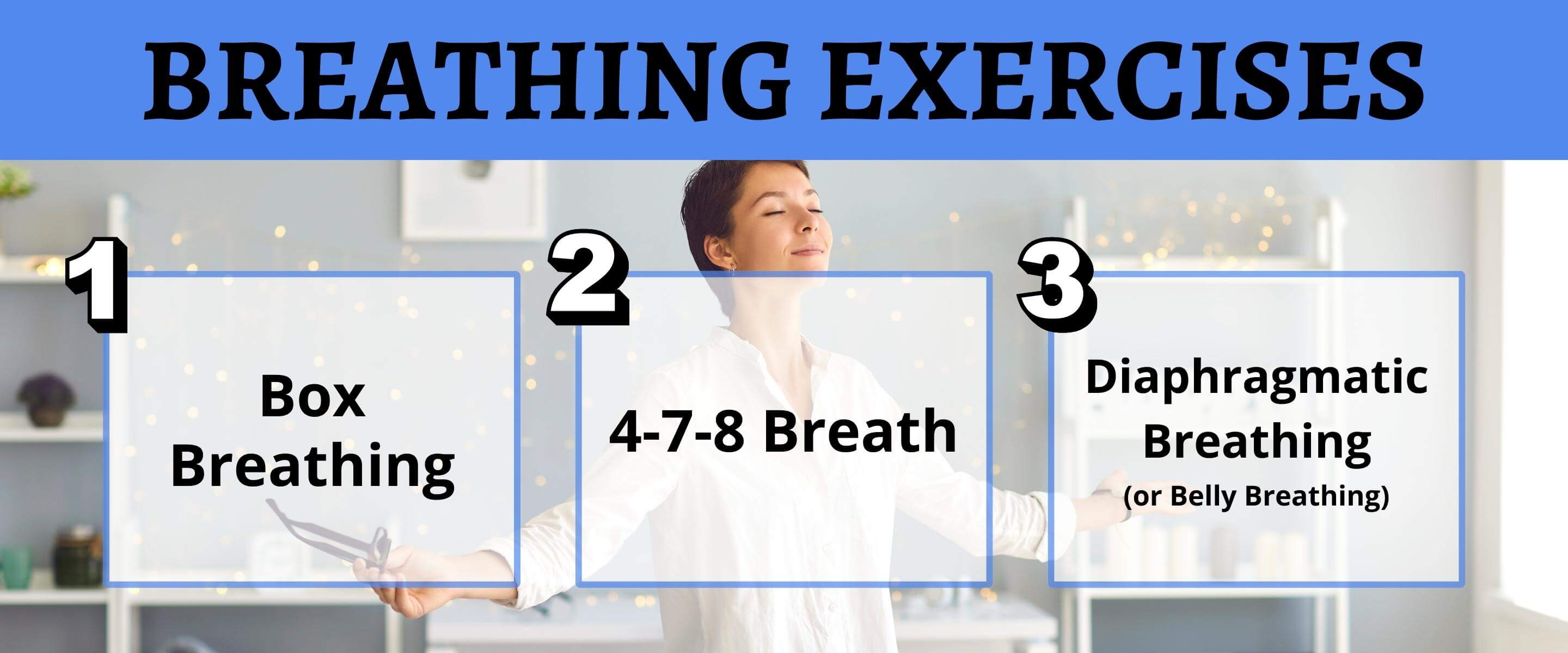
Breathing Exercises:
- Box Breathing: Inhale slowly for a count of four, hold your breath for a count of four, exhale for a count of four, and then hold your breath again for a count of four. Repeat this pattern several times, focusing on the rhythmic nature of your breath to promote relaxation.
- 4-7-8 Breath: Inhale deeply through your nose for a count of four, hold your breath for a count of seven, and exhale slowly through your mouth for a count of eight. This breathing pattern helps activate the parasympathetic nervous system and induces a sense of calm.
- Diaphragmatic Breathing (or Belly Breathing): Place one hand on your abdomen, just below your ribcage, and the other hand on your chest. Take a slow, deep breath in through your nose, allowing your belly to expand as you fill your lungs with air. Focus on pushing your abdomen out, while keeping your chest relatively still. Exhale slowly through your mouth, allowing your abdomen to naturally deflate. Continue this pattern of deep diaphragmatic breathing, focusing on the rise and fall of your abdomen, for several breaths.
Voice
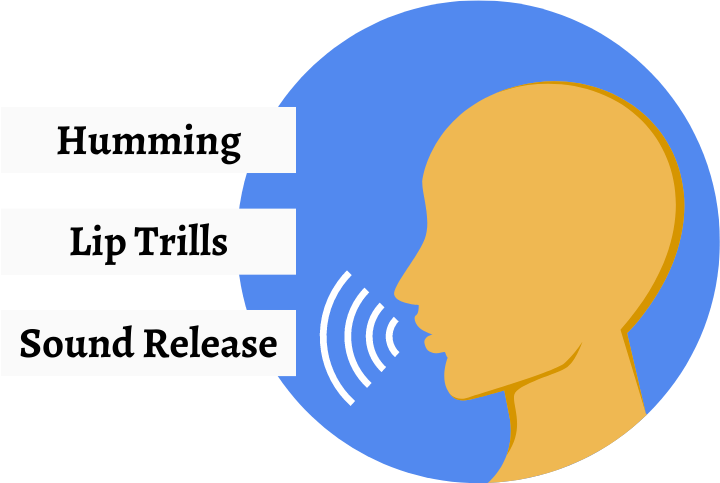
- Humming: The soothing vibrations created during humming have a calming effect, reducing anxiety and stress. Humming serves as a gentle vocal warm-up, relaxing the vocal cords and improving voice flexibility and clarity. By focusing on the breath and the physical sensations of humming, individuals can shift their attention away from anxious thoughts and ground themselves in the present moment. Humming is a simple yet effective technique that can help individuals feel more calm, centered, and confident when facing public speaking situations.
- Find a quiet and comfortable space.
- Close your eyes and take a few deep breaths to relax.
- Begin to hum softly, allowing the vibration to resonate in your throat and chest.
- Focus on the sensation of the vibration and the sound you are producing.
- Gradually increase the volume and intensity of your humming, feeling the vibration throughout your body.
- Continue humming for a few minutes, allowing the sound and vibrations to calm your nervous system and ground you in the present moment.
- Lip Trills: Lip trills, also known as lip buzzing, can help with public speaking anxiety by relaxing the vocal apparatus and reducing tension in the body. The gentle vibration created by lip trills stimulates the vagus nerve, which promotes a sense of calmness and relaxation. This exercise serves as a vocal warm-up, preparing the vocal cords for speaking and improving voice control and resonance.
- Relax your lips and keep them loosely closed.
- Exhale through your lips, causing them to vibrate rapidly, creating a "brrr" or "trrr" sound.
- Start with a gentle and slow vibration, and then increase the intensity and speed of the lip trill.
- Feel the vibrations in your lips, face, and even your chest as you continue the lip trill.
- Practice lip trills for a few minutes to release tension, warm up your vocal cords, and improve vocal resonance. Vocal Sirens: Vocal sirens can help with public speaking anxiety by promoting relaxation, breath control, and vocal flexibility. By smoothly transitioning between low and high pitches, vocal sirens encourage a deep and controlled breath, activating the parasympathetic nervous system and reducing anxiety. The fluid movement of the voice during sirens releases tension in the vocal cords and muscles, allowing for a more relaxed and resonant voice.
- Take a deep breath and begin making a low, gentle sound like "mmmm."
- Gradually and smoothly slide your pitch upward, as if mimicking the sound of a siren.
- Continue sliding your pitch up and down, exploring your vocal range, and feeling the vibrations in your throat and chest.
- Experiment with different volumes, speeds, and pitch variations.
- Vocal sirens can help relax your vocal cords, warm up your voice, and bring awareness to the physical sensations of your voice production.
- Sound Release (This is a fun one): Sound release is a technique that involves using vocalization and intentional sound-making to release tension and reduce public speaking anxiety. It focuses on the idea that sound can serve as an outlet for pent-up emotions and physical tension.
- Find a private space where you can make sounds freely without judgment or inhibition.
- Take a deep breath and release any tension or stress through vocalization.
- Experiment with different sounds such as sighs, groans, or even primal sounds.
- Allow yourself to express and release any pent-up emotions or anxiety through sound.
- This exercise helps release physical and emotional tension, allowing you to feel more grounded and present.
Somatic techniques hold immense importance in managing public speaking anxiety. By recognizing the connection between the body and mind, these techniques provide valuable tools to regulate physiological responses, cultivate presence, reduce stress, optimize body language, and foster empowerment. Somatic techniques empower individuals to embrace their body's wisdom, harness their innate potential, and confidently share their ideas with the world.

Behavioral Techniques
What are Behavioral Techniques?
Behavioral techniques for public speaking anxiety focus on modifying specific behaviors and actions to alleviate anxiety and enhance performance. These techniques are all about changing the way you act and behave when you're speaking in public.
Why are Behavioral Techniques important?
By modifying behaviors and actions, individuals can gradually increase their confidence and self-assurance, regulate their anxiety responses, and optimize their speaking performance. These techniques empower individuals to face their fears, gradually expose themselves to speaking situations, and develop the necessary skills to deliver impactful speeches. Ultimately, behavioral techniques offer a pathway to transform public speaking anxiety into an opportunity for growth and success.
The Behavioral Techniques:
1) Gradual Exposure: Gradual exposure involves gradually exposing oneself to speaking situations, starting with less challenging ones and gradually progressing to more anxiety-inducing scenarios. By incrementally increasing exposure, individuals can build confidence and desensitize themselves to the fear of public speaking.
Exercise:
- Make a list of the things you don’t want to happen in speaking situations
- Examples (Mind going blank, voice trembling, saying something incoherent, long pause, not able to answer a question, etc)
- Use one of those things on the list and gradually expose yourself to those situations, going from less challenging to more challenging situations. You can expose yourself to those situations by acting them out.
Example:
- Exposure To - Forgetting what to say
- Less challenging situations (with friends, family, colleagues, shopping): as you have a conversation, act out that you are forgetting what you’re going to say by preparing a phrase you want to say ahead of time.
- Move into more demanding situations: Act out that you are forgetting to say something
IMPORTANT - Exposure is exposure to your feared outcome! If you just go into speaking situations and NEVER expose yourself to forgetting a line (using the example above), then you’re not exposing yourself to what makes you afraid in the first place. Does this make sense?
2) Practice and Rehearsal: Practice is crucial for overcoming anxiety. By rehearsing speeches or presentations multiple times, individuals become more familiar with the material, gain confidence in their delivery, and reduce anxiety. Practice also helps in refining timing, transitions, and overall flow, making the actual performance smoother.
Tips on Practice & Rehearsal:
- Write down X times you’re going to practice. After you finish those X times, carry on with your life.
- Time Yourself (If you have a time frame): Practice speaking within a designated time frame. Set a timer or use a stopwatch to ensure you stay within the allotted time. This helps you maintain focus, avoid rushing, and ensures that you cover all the important points without going overboard.
- Record and Review: Record yourself practicing or delivering a rehearsal presentation. Use a smartphone, webcam, or voice recorder to capture your performance. Then, take the time to review the recording objectively. Pay attention to areas where you can improve, such as clarity, pace, and body language.
- Refine Your Delivery: Pay attention to your speaking style and fine-tune it. Practice enunciating words, varying your tone of voice, and incorporating appropriate pauses for emphasis. Work on your body language, such as maintaining good posture, making eye contact, and using appropriate gestures to enhance your message.
- Seek Feedback: Involve others in your practice sessions. Ask trusted colleagues, friends, or mentors to provide constructive feedback on your presentation skills. Their fresh perspective can offer valuable insights and help you identify areas for improvement that you might have overlooked.
- Practice in Different Settings: Try practicing in various settings that mimic the actual presentation environment. This could include standing at a podium, using presentation slides, or simulating a meeting room setup. Familiarizing yourself with different scenarios helps you adapt and feel more comfortable during the real presentation.
- Rehearse Responses to Questions: Anticipate potential questions or concerns your audience might have and prepare thoughtful responses. Practice answering these questions concisely and confidently, ensuring that your responses align with your main messages.
3) Audience Engagement: Engaging with the audience can help shift the focus away from self-consciousness and anxiety. Techniques such as making eye contact, using gestures, and actively involving the audience through questions or interactive elements can create a sense of connection and support. This interaction can alleviate anxiety and make the speaking experience more enjoyable.
Do these things for audience engagement:
- Ask questions - This might look simple but how often do you usually plan “questions” in your presentation or when you have to speak in the meeting? Most people plan out exactly how they need to answer but they do not strategically plan questions they can ask throughout the time they talk
- Use the word YOU use the pronoun “you” more when you speak. When you use the word, “you”, people’s ears perk up even more because you’re specifically talking to them instead of just using “I”, or “my” the whole time. Here are different ways, you can use “YOU”, more
- Some of you might be thinking…
- Some of you might be feeling…
- You might be asking yourselves…
- You might be curious about it.
- Perhaps some of you are concerned about…
- I sense that some of you may have questions about it.
- Imagine you….
- Take a moment to think as if you were…
- Suppose you are…
- Place yourself in the situation of...
- Have you ever…
- What if you could…
- What can you do to…
- What do you think…
- Remember, you are unique and have your strengths and talents.
- Believe in yourself, and others will believe in you too.
- Don't be afraid to ask for help when you need it. You don't have to go through everything alone.
- Saying out loud what your audience might be thinking or feeling:
- Painting a picture:
- Questions:
- Statements:
4) If/Then - These are situations you plan where something could go wrong in your speaking situations. You write out IF something happens, THEN what actions you can take.
For example, IF my voice trembles THEN I’ll take this action
Exercise: Take 10 minutes and write down ALL your IF/THENs for your speaking situations.
Examples:
- IF I forget my lines, THEN I will pause, take a deep breath, and refer to my notes or slides to get back on track.
- IF I start speaking too fast due to nervousness, THEN I will remind myself to slow down, take a moment to breathe, and continue at a steady pace.
- IF I notice my hands shaking, THEN I will discreetly clasp them together or place them on the podium to steady myself.
- IF I encounter a challenging question from the audience, THEN I will acknowledge the question, take a moment to gather my thoughts, and respond honestly or offer to follow up later with a more detailed answer.
Make Your Body Language BIGGER/Voice LOUDER - Most people shrink in their body language or voice when they get anxious which is very common because it’s the act of wanting to hide the nerves. Instead do the opposite, make your body language bigger.
Here are some scenarios:
When your voice is trembling - start speaking louder!
Most people will tend to let their voice slow down or they want to hide it completely. When you speak even louder, you will make your voice heard that’s because you’re increasing airflow in your voice, you engage the vocal muscles in your voice production and you alter your vocal cord tension to produce a more resonant and projected voice.
When you start to feel small: Bring your arms/hands toward the audience or outside the box
You see most people tend to get chicken wing arms when they get nervous (meaning, their arms/elbows tend to start sticking to their sides and they keep it in), instead gesture towards your audience or bring your hand out of the box (expanding your whole arm out). When you expand your arms this way
When you lose the train of thought or want to look away - Look at your audience in the eyes, stand up, or sit up taller.
When people tend to get nervous or they lose their train of thought, they tend to want to look down or away to make sure no one sees them because they feel embarrassed. The next time you might lose your train of thought, look directly at your audience and into their eyes instead. When you do this, your audience will see that you are looking at them in the eyes and that you’re connecting with them. On your side, trust that the space and the audience will guide you to what to say next.
4) Move Your Body BEFORE You Have To Speak:
When you are in front of a scary lion, you get to run. Physically, you get to release your tension by moving. In a speaking situation, you’re usually static in one place. Move your body before you have to speak to gather your energy while releasing tension.
Here are some things you can do (do not take these as silly):
- Take a walk: Walk around the building once or twice. Once you get out there, because of what’s moving in the streets or the neighborhood, your mind will start thinking differently.
- Do 10X Exercises - Do a set of 10 reps of pushups, jumping jacks, squats, or whatever they could be.
- Physical exercises engage your muscles and help release built-up tension in your body. Anxiety often manifests as physical tension, and by doing exercises, you can alleviate some of the muscle tightness and discomfort associated with nervousness. At the same time, these physical exercises trigger the release of endorphins, which are natural chemicals in the brain that act as mood elevators and pain relievers. These endorphins can help reduce feelings of stress and anxiety, leading to a more relaxed state of mind.
- Seek Real-Life Speaking Opportunities
Here are different ways you can seek real-life speaking opportunities:
- Story slams
- OpenMics
- Toastmasters
- Join a public speaking class
- Work with a coach
- Volunteer for presentations or help out at events where they have speaking roles
- Download a public speaking app
- Volunteer at your work to host an event
- Attend networking events
- Go live on social media
- Tell people that you are looking for more speaking opportunities

Street Smart Techniques
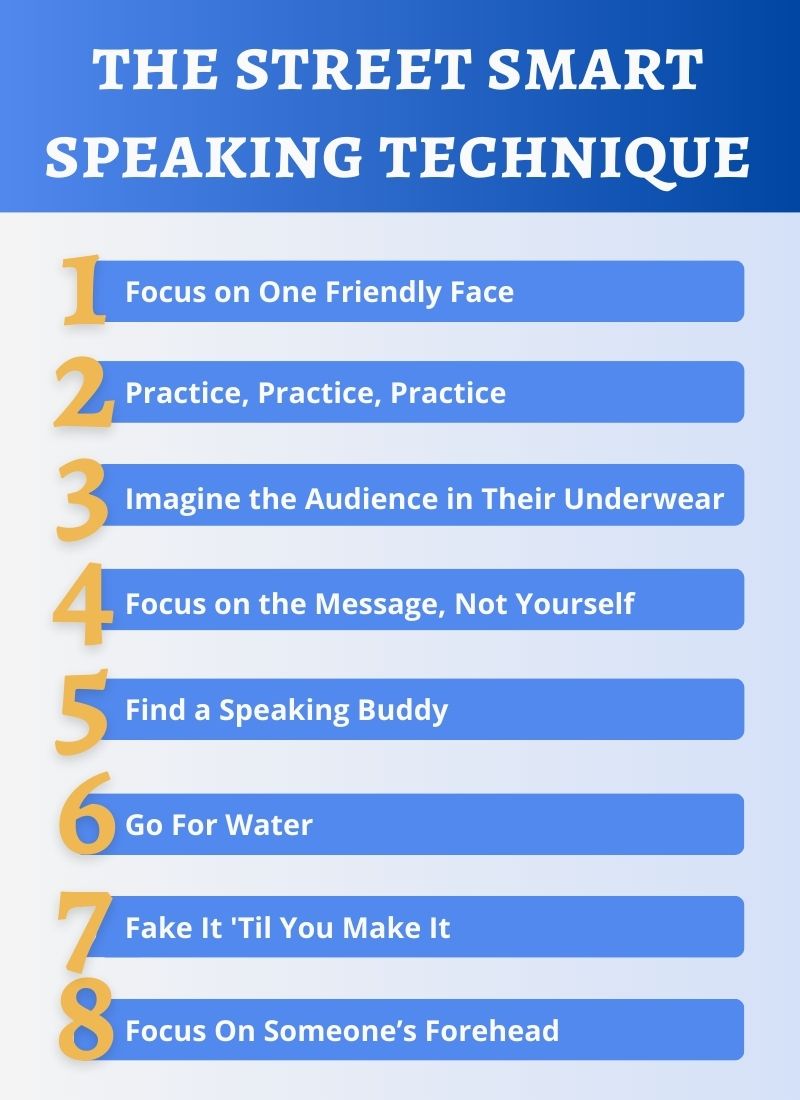
What are Street Smart Speaking Techniques?
Street smart speaking techniques for public speaking anxiety are informal and practical strategies that people may have learned through personal experiences, tips from others, or trial and error. These techniques are not necessarily backed by formal research but have been passed down through generations and are often found to be effective by individuals who have used them.
Why is Street Smart Speaking Techniques important?
Street smart speaking techniques are born out of practical wisdom and real-life experiences. They are often based on what has worked for others in similar situations. Depending on which culture and environment you are in, these techniques may be culturally relevant and align with social norms and practices, making them relatable and acceptable in various contexts.
The Street Smart Speaking Techniques:
- Focus on One Friendly Face: Find a friendly face in the audience, someone who appears supportive or engaged. Make occasional eye contact with that person to feel more connected and less overwhelmed.
- Practice, Practice, Practice: Rehearse your speech multiple times before the actual event. Practice in front of a mirror, record yourself, or present to friends and family for feedback. Familiarity with the material can boost confidence.
- Imagine the Audience in Their Underwear: This classic technique involves visualizing the audience in a humorous or vulnerable state, which can help you feel more at ease and less intimidated by their presence.
- Focus on the Message, Not Yourself: Concentrate on the importance of your message and the value it brings to the audience. Shift the focus away from yourself and onto the knowledge you are sharing.
- Find a Speaking Buddy: Have a friend or colleague in the audience who you can make eye contact with and imagine you are speaking directly to them. Having a friendly face can provide a sense of support.
- Go For Water: Bring a glass of water with you. Taking a sip of water when needed provides a natural pause and a moment to regroup.
- Fake It 'Til You Make It: Act as if you are confident, even if you don't feel that way initially. Over time, this can influence your actual feelings of confidence.
- Focus On Someone’s Forehead: When speaking, focus on a spot slightly above the audience's heads or on a point at the back of the room. This helps you maintain composure and reduces distractions.

Unconventional Techniques
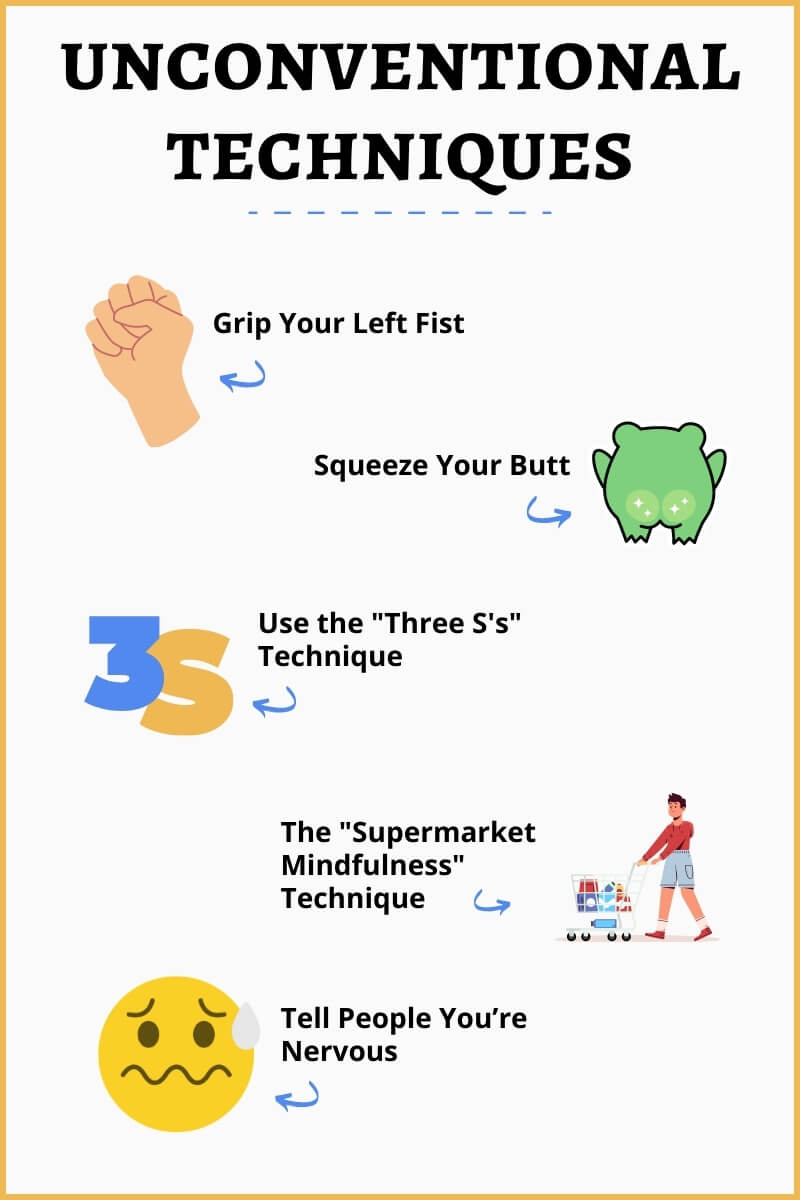
What are Unconventional Techniques?
Unconventional public speaking anxiety techniques are unique approaches that may not be commonly used or recommended, but some individuals find them effective in managing their anxiety. These techniques can be outside the norm but are worth exploring if they resonate with you.
Why are Unconventional Techniques important?
Unconventional public speaking anxiety techniques are important because they highlight the diverse and individual nature of managing anxiety. While traditional techniques like deep breathing, positive visualization, and rehearsing are widely recognized and embraced, unconventional approaches offer an alternative perspective that might resonate better with certain individuals. The importance of these techniques lies in their ability to cater to a broader range of personalities, preferences, and circumstances.
Here they are:
Grip Your Left Fist: Dynamically squeezing your left hand is effective in preventing choking under pressure.
In a nutshell, this works because it activates the right hemisphere of your brain.
The left hemisphere is often associated with logical and analytical thinking, language processing (speech and comprehension), mathematical abilities, and fine motor skills. Often when individuals are overthinking, their left hemisphere lights up. The right hemisphere, on the other hand, is often linked to creativity, spatial awareness, facial recognition, emotional processing, and artistic abilities - think of being in flow.
Your left hemisphere of the brain controls the right side of the body and your right hemisphere controls the left side of your body.
When individuals grip their left fist, this tends to activate the right hemisphere of the brain and balances out the overdrive from the left hemisphere. That is why when you are under pressure, grip your left fist!
Squeeze Your Butt: When you hear this, you probably laugh or think it’s silly at first. But really, try and go squeeze your butt right now. You can’t help but feel silly and think of those strong buttock muscles you’re going to build. When you are getting ready to speak and your anxiety is building up, squeeze your butt! This will help distract you from your negative thoughts and gives you something else to focus on. On top of that, you can squeeze other parts of your body. Squeeze for a few seconds, relax, then repeat. When you do this, you create tension and release tension. Just don’t fart.
Use the "Three S's" Technique: Imagine the audience is made up of your Supporters, your Sidewalkers (neutral listeners), and your Saboteurs (those who may be critical). Focus on connecting with your Supporters and Sidewalkers, as they are more likely to be receptive and encouraging.
The "Supermarket Mindfulness" Technique: Imagine you are in a busy supermarket, and each person in the audience represents an item you need to find. Silently observe the "items" (people) without feeling judged or scrutinized. Just like in a supermarket, all items are not for you. Each person that you’ll be speaking to thinks differently than you do. If they make a face or say something mean to you, know that they are a different style.
Tell People You’re Nervous: Acknowledge and tell your audience that you are nervous speaking. When you do this, the anxiety will instantly disappear as you find it okay to share with people that you’re nervous and your audience will appreciate you even more for being authentic, human, and real.

Influencer Techniques
Influencer Techniques are the tricks, tips, and strategies that influencers and celebrities have shared that helped them with their public speaking.

Tim Ferris’s Weird Mental Speaking Hack To Calm His Nerves
The key is to practice under stress.
Here’s what Ferris did.
In preparation for his TED Talk, Ferris employed a rigorous practice approach, seeking feedback from small groups of strangers and integrating their suggestions into subsequent rehearsals.
To simulate this stress, he deliberately increased his heartbeat by doing pushups and consuming double espressos before each practice session. By subjecting himself to these conditions, he aimed to gauge his ability to deliver the content effectively under heightened stimulation. He wanted to "see if I could handle the stimulation."
Adam Grant - Don’t Try To Calm Yourself Down
Don’t try to calm down, turn your anxiety into excitement
In 2014, Adam Grant wrote a piece in his LinkedIn titled How I Overcame The Fear Of Public Speaking. This is one of his top tips from the article.
In public speaking, trying to calm down may not be the most effective strategy. Research shows that embracing excitement rather than attempting to relax leads to more compelling and confident speeches. Physiologically, we have a "go system" that energizes us and an opposing "stop system" that makes us cautious. Instead of suppressing anxiety, it's better to redirect it into excitement, a powerful emotion that can fuel our performance. Embracing the reasons to speak, such as delivering a meaningful message and engaging the audience, can help reduce anxiety and enhance enthusiasm. Remember, even successful speakers like Richard Branson acknowledge that some nervousness is natural, so embracing excitement is a more practical approach to tackling public speaking fears.
Taylor Swift - Take a natural supplement to manage anxiety
In an interview with Elle magazine, Taylor reveals '30 Things I Learned Before Turning 30’
Taylor shares, "Vitamins make me feel so much better!" she wrote. "I take L-theanine, which is a natural supplement to help with stress and anxiety.”
L-theanine is an amino acid that is commonly found in tea leaves, particularly in green tea. It has been studied for its potential effects on promoting relaxation, reducing stress, and improving cognitive function. For public speaking anxiety, some individuals have reported positive effects from taking L-theanine supplements. It is believed to promote a sense of calmness without causing drowsiness, which can be beneficial for managing anxiety and nervousness associated with public speaking.
Mel Robbins’s Secret Flip To Help Your Mind And Body To Get Ready To Talk
In a talk addressing speaking anxiety, Mel Robbin offers this one secret tip as your stomach is feeling the butterflies, your hands getting clammy and you start shaking.
When you start noticing that your body is physically feeling the symptoms, say to yourself, “My body is getting ready to talk”.
“My body is getting in a state ready to do something.” This is what it means on the positive side. You want to relabel the meaning you’ve created towards your speaking anxiety.
Mel says - Give it 6 weeks, do this over time, and start thinking and saying, “My body is getting ready to talk” and you will naturally start feeling this way.

BostonSpeaks Top Picks
Gina’s List:
1. Visualization:
Visualization is a powerful tool, so make sure you’re using it to your advantage (when we don’t visualize intentionally, we often end up unconsciously visualizing what we don’t want to happen!). Here are some ways to apply this:
- Visualize, in detail, your speech or meeting going well. Evoke the feelings you want to feel. Visualize your posture, your facial expressions, others’ facial expressions, the firm grip of a handshake, the smells in the room, etc. Doing this creates a mental bridge to the situation playing out that way.
- Visualize your Fear Monster. Close your eyes and picture what your public speaking fear looks like, visually. You have likely never done this before, so take a few moments to close your eyes and really see it. Is it a big ball of crazy spiky energy? Is it a little troll? Get clear on what it looks like. Then, slowly, take its power away. You can do this by taking some deep breaths and shifting the image in your mind to something small, or innocent. For example, take the color out. Soften any spikes or edges. Freeze any movement. Put the image in a box that only you have the key to. There’s no right or wrong way to do this.
- This process can help re-store the unconscious image of speaking fear from one that feels overwhelming, to one that feels manageable, weak or less intense.
- Visualize your Inner Critic and your Higher Self.
- Your Inner Critic is that voice in your head with all the self-doubt. Visualize the Inner Critic as a character (e.g., a version of you? Your mother? A toad? Whatever resonates with you). Then name it. This creates distance between you and the inner critic.
- Next, visualize your Higher Self. The most authentic version of you. The version that is aligned with your values and passions. This is you when there’s no fear. Visualize that version. Name it.
- Remember that when you feel anxiety it means the inner critic has taken the wheel (like in the movie Inside Out). In those moments of anxiety, visualize the Higher Self saying to the Inner Critic - Thanks for trying to help, but please step aside, I got this!
2. Hypnosis:
This might seem “woo woo” but hypnosis can be very effective! You can hire a professional or find a guided meditation online.
- You can find some examples of online guided meditations here: YouTube link here another one here and one more here.
3. Self-Care:
Set yourself up for success by taking care of your mind, body and spirit.
- For example, what does your body need to recharge? Maybe a workout, maybe a nap, maybe a healthy meal. Or maybe your spirit needs to take a break from work and connect with loved ones or your dog.
4. Bio-Hack Your Neurotransmitters:
Our emotions are connected to our neurotransmitters, chemical messengers in the brain. Intentionally targeting your neurotransmitters is one trick to mastering your mindset. Some examples:
- Boost oxytocin: Look at a photo of something that makes you feel your heart explode (you know, like your kid, a puppy, or even yourself as a baby!) Research shows this increase oxytocin which will help you feel more grounded and better able to connect with your audience.
- Boost serotonin: go out and spend some time in nature.
- Boost testosterone and reduce cortisol: 2 minutes of power poses (read more about power posing above under Somatic Techniques).
5. Grounding:
Ever wonder why you feel relaxed after spending time at the beach? One reason is because having your toes in the sand helps ground you. Literally. Grounding, or “earthing” is a somatic technique where you connect your body to the earth’s natural electric charge. Grounding helps the body absorb Earth’s electrons and supports relaxation and overall health and well-being. So whether it’s grass, sand, dirt or rock, go outside barefoot! Read more about it here.
6. Music:
Make a power playlist, or list of songs that make you feel happy, confident or grounded. Put it on any time you feel nervous, especially right before a speech! Even better - choose your favorite song as your “walk-out song”...you know, like if you were to walk out on stage, the song that would represent YOU and the energy you want to create in the room.
7. Pre-Speaking Ritual:
Take some ideas from this document and create a 2-10 minute go-to ritual or routine. You can do the ritual before any speaking engagement and this practice will set you up for success, every time.
- My personal pre-speaking ritual is:
- Watch a couple minutes of stand-up comedy, listen to a song that pumps me up, 1 minute of visualization.
- Another Example: Go on a walk around the block, 2 minutes of deep breathing, have a cup of tea.
8. Perspective:
Remember HOW SMALL YOU ARE - watch this video.
Kit’s List
If the build-up to the speaking event gives you the most anxiety, do this:
- Create a list of quotes, reframes, and messages that you can look at on your phone or on a piece of paper around “the meaning of why you get anxious as a speaker”
- "Embrace the nerves, for they remind you that you care deeply about your message."
- "Anxiety is a sign that you're challenging yourself and stepping outside your comfort zone."
- "Each moment of anxiety is an opportunity for growth and self-discovery."
- "Nervousness shows you're human, and authenticity resonates with audiences."
- "Let anxiety be your ally, propelling you towards excellence."
- "It's okay to be nervous; it means you're invested in making a difference."
- More on this list here
If you don’t have an answer to a question and feel flustered, do this:
- Take a journal out, ask yourself questions, and write down why you get flustered when you don’t have an answer to a question (even though you know you can say, “I don’t have the answer right now, can I get back to you?”.
If you’re afraid that you’re going to appear physically nervous in front of others, do this:
- Show it, instead of hiding it. Acknowledge it, instead of downplaying it. It's hiding it that makes you get more nervous in the first place.
If you get in head your because you didn’t sound the way you wanted to sound, do this:
- Audio or video record yourself and play it back to yourself to see how you sounded.
If someone in the audience makes a face, or maybe you can’t even see your audience because of Zoom, do this:
- Sustain your energy. If you start running and in the middle you get tired, the race isn’t over, sustain your energy. Ignore the distractions. You can analyze it afterward. The problem is the overanalyzing at the moment that makes us too self-conscious.
If you have some time right now to write something down on paper...Create Your Speaking Win List
Do This: Create a list of past public speaking successes and fully immerse yourself in that memory. Name that event! Remember how you felt. Visualize yourself bringing that same confidence and success into your current speaking engagements.
Examples of past successful speaking events you can recall:
- Keynote Address
- Training Session
- Persuasive Pitch
- Memorable Workshop
- Panel Discussion
- Memorable Toast or Speech
- Successful Sales Presentation
- Conference Presentation
- Facilitating a Productive Discussion
- Delivering a Compelling Proposal
- Problem-Solving and Decision-Making
- Presenting Research Findings
- Influencing Stakeholders
- Providing Valuable Insights
- Leading a Productive Brainstorming Session
- Mediating Conflict
- Presenting Project Updates
- Contributing Constructively
***
Whew, that's ALOT of techniques. From employing deep breathing exercises to harnessing the power of positive visualization, each technique serves as a valuable resource to manage anxiety and bolster self-assurance.
Jot down your favorite ones and start putting them into action.
Your Next Steps To Break Free From Public Speaking Anxiety
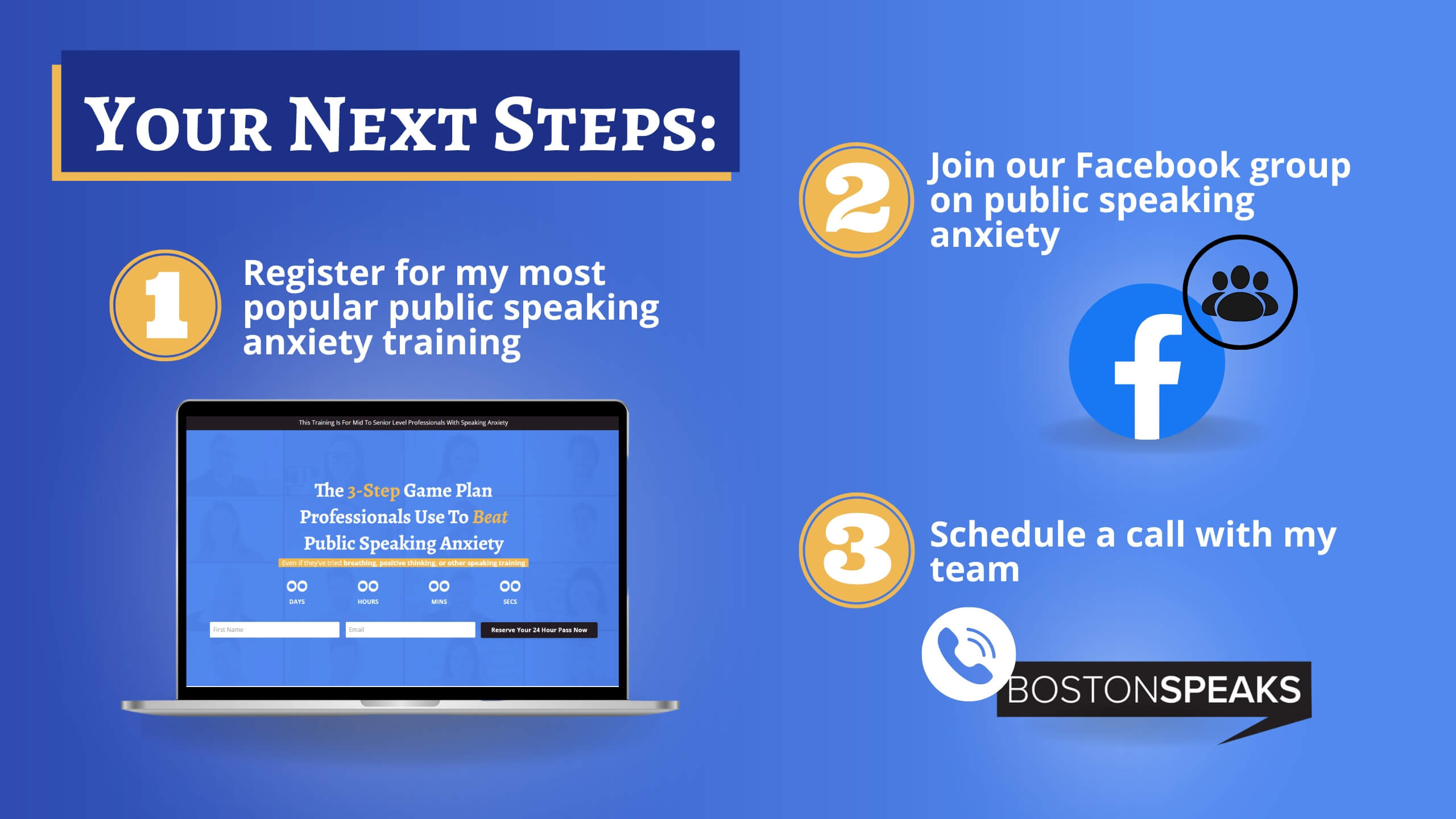
- Register for the popular public speaking anxiety training where you'll go more in-depth about the psychology of public speaking anxiety: https://www.bostonspeaks.com/nofearspeaking
- Join our Facebook group on public speaking anxiety: https://www.facebook.com/groups/nofearpublicspeaking
- Schedule a call with us to see how we can help you break free from public speaking anxiety: Click here!
To Your Speaking Success,
Gina and Kit





